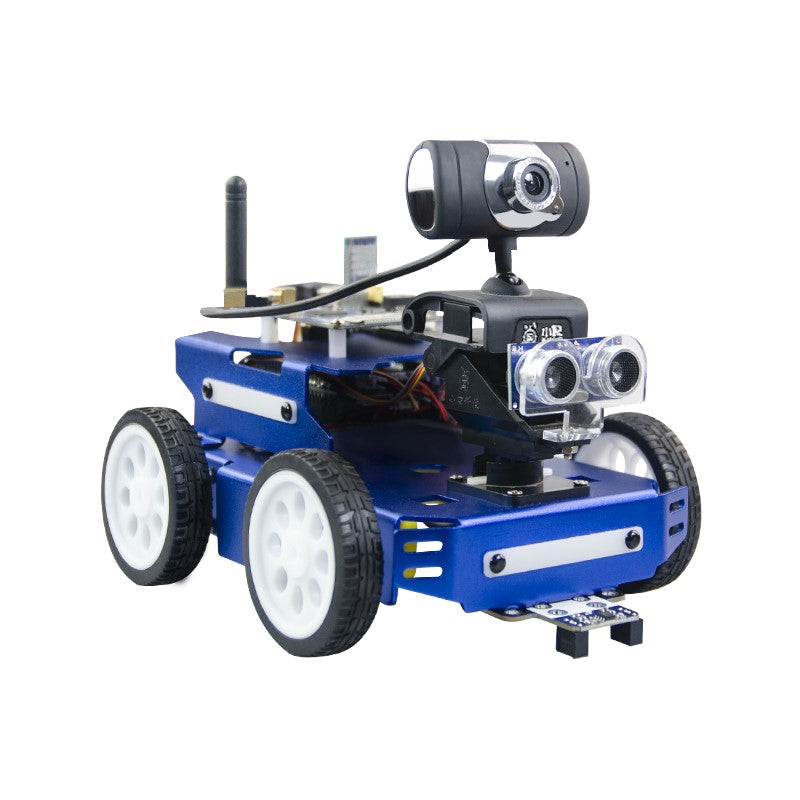Building K12 STEM educational coding smart Robot cars compatible Raspberry Pi with XiaoR GEEK Top-quality parts
DS-X wheeled AI educational robot car--Small but complete.

| 1. WiFi wireless remote control | 10、Distance voltage display function | 19. Gesture recognition |
| 2. WiFi wireless video transmission | 11. Real-time mode display function | 20. Object tracking |
| 3. Motor control | 12. Headlight function | 21. Object recognition |
| 4. Servo control | 13. Turn signal function | 22. visual obstacle avoidance |
| 5. Ultrasonic walking the maze | 14. Voltage indication | 23. 37 kinds of sensor expansion experiment |
| 6. Ultrasonic ranging backhaul | 15. Horn function | |
| 7. Ultrasonic distance measurement | 16. Built-in music | |
| 8. Infrared line inspection function | 17. PS2 handle control function | |
| 9. Infrared anti-drop function | 18. Bluetooth control |

|
GFS-X crawler AI educational robot car---Dash ahead to go what one yearns for
The GFS-X robot is an advanced vehicle-shaped robot with a crawler structure. The car body is large in size and easy to install various sensors and expansion modules. The whole cars weighs 2.5kg and the maximum speed can reach 0.8m/s. It is suitable for different application scenarios such as rugged roads, climbing, and crossing gully. The product is also equipped with the commonly used Arduino, STM32, and Raspberry Pi three maker education hardware platforms, open hardware interface and software API interface, GFS-X robot also has AI machine vision, allowing users to learn and expand visual line inspection, Artificial intelligence features such as face recognition and color recognition.
Features
* Large size platform, easy to expand
* AI machine vision
* The crawler is shock-absorbing, like walking upon flat ground.
| 1. WiFi wireless remote control | 10、Distance voltage display function | 19. Gesture recognition |
| 2. WiFi wireless video transmission | 11. Real-time mode display function | 20. Object tracking |
| 3. Motor control | 12. Headlight function | 21. Object recognition |
| 4. Servo control | 13. Turn signal function | 22. visual obstacle avoidance |
| 5. Ultrasonic walking the maze | 14. Voltage indication | 23. 37 kinds of sensor expansion experiment |
| 6. Ultrasonic ranging backhaul | 15. Horn function | 24. Robotic arm function |
| 7. Ultrasonic distance measurement | 16. Built-in music | 25. Visually identify colors |
| 8. Infrared line inspection function | 17. PS2 handle control function | 26. Visual recognition line inspection |
| 9. Infrared anti-drop function | 18. Bluetooth c |
Parameter
Chassis
Size: 230*210*40mm
Weight: 2.5kg
Material: Aluminum alloy stamping and forming
Treatment process: anodic surface oxidation
Way of travel: crawler rear drive
Max speed: 0.8 m/s
Load capacity: 3kg
Camera
Pixel: 1.2 million hardware pixels
Resolution: 720P
Output interface: USB2.0
Video format: Mjpeg
Lens wide angle: 110 degrees
Digital Transmission System
Communication mode: WiFi/Bluetooth/PS2
Communication frequency: 2.400-2.4835GHz
Effective distance: 40-80 meters
Control method: APP/PC/PS2 handle
Main control system
Driver board: PWR.
Multi-function voltage regulator driver expansion board
Main control platform: Arduino/STM32/Raspberry Pi
Programming language: C/Python
Scalable IO: 12pcs Regulated output: 5V 1.5A
Power
Battery type: lithium polymer power battery
Output voltage: 12V
Max output current: 5A
Battery capacity: 2200mAh
Overshoot and over discharge protection: included
Cascade mode: 3 strings of 18650
Robotic arm
Degrees of freedom: 4
Joint servo: XR-R015
Torque of single servo: 15KG
Clamping accuracy: 3°
Max clamping weight: 280g
Material: aluminum alloy
Surface technology: anodic surface oxidation (black)
Abundant curriculum system (For advanced)

|
 |
 |
 |
| Chapter 1 Know Arduino | 4.6 Functions |
| 1.1 What is Arduino | 4.7 Input and output |
| 1.2 Arduino program development process | Chapter 5 Arduino Getting Started Example Walkthrough |
| 1.3 Why use Arduino | 5.1 Arduino control RGB lights |
| 1.4 X series hardware introduction | 5.2Sound control lights in corridor |
| Chapter 2 Equipment Assembly | 5.3 Buzzer experiment |
| Chapter 3 Starting the Arduino Journey | 5.4 LCD12864 character display |
| 3.1 Set up a development environment | 5. 5 DHT11 temperature and humidity detection |
| 3.2 Introduction to Arduino IDE | Chapter 6 X-series project case explanation |
| 3.3 The first Arduino program | 6.1 Motor experiment |
| 3.4 Upload factory program | 6.2 PS2 control experiment |
| Chapter 4 Arduino Basic Syntax | 6.3 Infrared sensor experiment |
| 4.1 Variables and constant light | 6.4 Ultrasonic sensor experiment |
| 4.2 Data type | 6.5 Arduino and MCU communication protocol |
| 4.3 Array | 6.6 Arduino control RGB lights |
| 4.4 Conditional judgment statement | 6.7 Application of steering gear |
| 4.5 Loop statement | 6.8 Serial port data reception and analysis |


